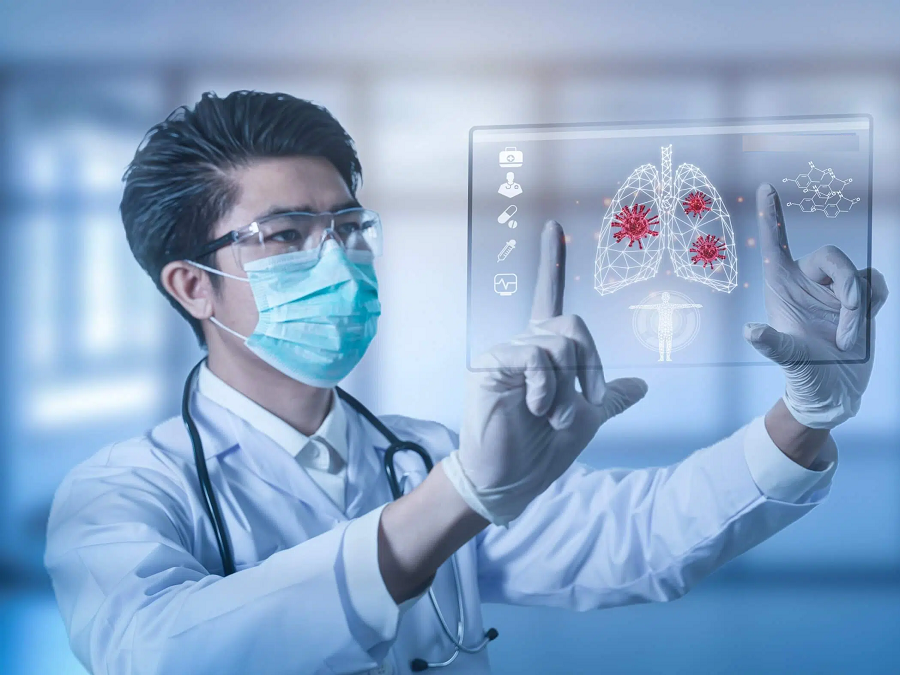Interactive Medical Imaging
Medical imaging technology has seen significant advancements in recent years, leading to improved diagnosis and treatment of diseases. Breakthrough innovations such as artificial and augmented intelligence, augmented and virtual reality combined with 3D imaging, new approaches to nuclear imaging, and portable and wearable scanners are reshaping the medical imaging field. The increasing sophistication of cross-sectional imaging with very rapid development and integration, new flat panel detectors, and digital image acquisition have improved image quality and decreased radiation dose.
Four major trends in medical imaging technology are artificial intelligence, virtual and augmented reality, 3D medical imaging, and enterprise imaging. Advanced medical imaging techniques such as computed tomography (CT), positron emission computed tomography (PET), magnetic resonance imaging (MRI), single-photon emission computed tomography (SPECT), ultrasound (US), and digital mammography reveal the internal anatomy and physiology of the body. The WHO collaborates with partners and manufacturers to develop technical solutions for improved diagnostic imaging services in remote locations and provides training programs in the use and management of medical imaging with the aim of strengthening medical imaging. With each new advancement, medical imaging technology becomes more important to detecting and addressing nearly all of the maladies that threaten our health.
Real-Time 3D Visualization
Traditional medical imaging often presented clinicians with 2D images, requiring them to mentally reconstruct a 3D representation of the patient’s anatomy. Interactive medical imaging now offers real-time 3D visualization, allowing healthcare professionals to navigate through anatomical structures with unparalleled clarity. This capability is especially valuable in surgical planning, where a more comprehensive understanding of the patient’s anatomy is crucial.
Patient-Centric Diagnostic Tools
Interactive medical imaging extends beyond the confines of the radiologist’s office. Patients can now actively participate in understanding their medical conditions through interactive diagnostic tools. Whether exploring a virtual model of their own anatomy or visualizing the progression of a disease, patients gain a more intuitive grasp of their health, fostering informed decision-making and improved health literacy.
Virtual Reality (VR) and Augmented Reality (AR)
The integration of virtual and augmented reality technologies has ushered in a new era of interactive medical imaging. VR allows healthcare professionals to immerse themselves in a virtual environment, manipulating and exploring medical images in 3D space. AR overlays relevant medical information onto the real-world view, aiding surgeons during procedures and enhancing the accuracy of interventions.
Precision in Practice
The integration of interactive medical imaging also holds immense potential for improving the efficiency and efficacy of treatment interventions. Surgeons, armed with interactive 3D models and augmented reality guidance, can navigate complex anatomical structures with unparalleled precision during procedures. This not only reduces the risk of complications but also contributes to shorter recovery times and improved postoperative outcomes. Additionally, the dynamic nature of interactive medical imaging allows for real-time adjustments and adaptations, ensuring that healthcare professionals can respond swiftly to unexpected challenges in the course of treatment. As we embrace the era of interactive medical imaging, the synergy between advanced visualization technologies and healthcare is paving the way for a more personalized, collaborative, and patient-centered approach to diagnostics and treatment.
Enhanced Collaboration and Education
Interactive medical imaging facilitates seamless collaboration among healthcare professionals. Radiologists, surgeons, and other specialists can remotely access and interact with the same set of medical images in real time. This not only streamlines the diagnostic process but also enhances interdisciplinary communication. Moreover, these interactive tools serve as invaluable educational resources, enabling medical students and residents to learn through hands-on exploration.
Empowering Informed Decision-Making
Interactive medical imaging empowers patients to actively engage in their healthcare journey. By visualizing their conditions and treatment options, patients can make more informed decisions about their care. This transparency fosters a collaborative relationship between healthcare providers and patients, leading to improved adherence to treatment plans and overall better health outcomes.
Remote Consultations and Second Opinions
The accessibility of interactive medical imaging tools has facilitated remote consultations and second opinions. Healthcare professionals can share interactive images with experts worldwide, seeking insights and recommendations without the need for physical presence. This democratization of medical expertise contributes to more comprehensive and accurate diagnoses.
Conclusion
The era of interactive medical imaging represents a paradigm shift in how we perceive, understand, and interact with diagnostic information. As these technologies continue to evolve, the impact on diagnostics, patient engagement, and healthcare delivery is poised to grow exponentially. Interactive medical imaging is not just a technological advancement; it is a catalyst for more informed decision-making, enhanced collaboration, and ultimately, improved patient outcomes. The journey towards a more interactive and patient-centric healthcare experience has only just begun.
Sources
- https://www.ahu.edu/blog/imaging-technology
- https://openmedscience.com/a-dive-into-the-world-of-3d-medical-imaging/
- https://u-next.com/blogs/data-science/3d-interactive-visualization-the-new-trend-in-the-medical-imaging-world/
- https://kodjin.com/blog/interactive-data-visualization-in-healthcare/
- https://www.bitsathy.ac.in/blog/exploring-the-innovations-of-dall-e-3/

